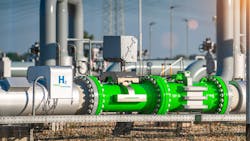Powering the Future: The Rise of Green, Pink and Blue Hydrogen and 7 U.S. Clean Hydrogen Hubs
As the world grapples with the need for sustainable and clean energy sources, hydrogen is emerging as a promising solution. Recognizing the immense potential of hydrogen, the U.S. government has earmarked $7 billion, actively subsidizing the development of hydrogen hubs (H2Hubs) across the country.
The H2Hubs will use different production methods, identified by color, to develop hydrogen. They include green, pink and blue hydrogen. Green hydrogen production uses wind, solar and other renewable energy sources to electrolyze water, separating hydrogen and oxygen. When nuclear power supports electrolysis, the hydrogen is called pink hydrogen. This process results in hydrogen production without any carbon emissions, making it an environmentally friendly fuel. On the other hand, blue hydrogen is derived from natural gas where hydrogen is produced through a steam methane reformer, with carbon capture and storage technologies in place to capture and store the carbon emissions, significantly reducing its carbon footprint compared to conventional hydrogen production methods.
H2Hubs Projects
Projects eligible for funding through the H2Hubs program must demonstrate production, processing, delivery, storage and end use of clean hydrogen. Here’s a closer look at the current projects in development:
1. The Gulf Coast Hydrogen Hub. Located in the heart of the U.S. energy industry. Houston’s HyVelocity Hydrogen Hub intends to establish a robust hydrogen ecosystem by integrating various sectors, including transportation, industry and power generation. By leveraging the region’s vast renewable energy potential, Houston aims to become a major player in green and blue H2 production, contributing to a sustainable energy transition. It anticipates 45,000 jobs with an allocated budget of $1.2 billion.
2. The California Hydrogen Hub. The Alliance for Renewable Clean Hydrogen Energy Systems in California is an ambitious initiative that focuses on green hydrogen production and utilization. With a strong emphasis on transportation, the hub will deploy hydrogen fuel cell vehicles and establish a comprehensive refueling infrastructure to support their widespread adoption. The project plans to generate 220,000 jobs, with a budget of up to $1.2 billion.
3. Appalachian Hydrogen Hub. The Appalachian Regional Clean Hydrogen Hub in West Virginia, Ohio and Pennsylvania will utilize the region’s natural gas resources to produce low-cost blue hydrogen and store carbon emissions in saline aquifers. With an allocated budget of up to $925 million, it aims to create more than 21,000 jobs.
4. The Heartland Hydrogen Hub. This hub will leverage renewable energy sources to produce green hydrogen for various applications, including transportation, industry, heating and power generation. By creating a comprehensive H2 infrastructure in Minnesota, North Dakota and South Dakota, it plans to create around 3,880 jobs, with a budget of up to $925 million.
5. The Mid-Atlantic Hydrogen Hub. Pennsylvania, Delaware and New Jersey will unlock hydrogen-driven decarbonization, using innovative electrolyzer technologies. By focusing on green hydrogen production and utilization, the hub will support the deployment of fuel cell vehicles and establish hydrogen refueling stations across the state. With an allocated budget of up to $750 million, it expects to create 20,800 jobs.
6. The Midwest Hydrogen Hub. The Midwest Alliance for Clean Hydrogen in Illinois, Indiana and Michigan — a key U.S. industrial corridor — will facilitate decarbonization across multiple sectors, including steel and glass production, power generation and transportation. Leveraging diverse energy sources like renewables, natural gas and nuclear energy, it aims to create 13,600 direct jobs, with a $1 billion budget.
7. The Pacific Northwest Hydrogen Hub. Covering Washington, Oregon and Montana, the hub will produce clean hydrogen through electrolysis, driving down costs and promoting accessibility. This initiative aligns with these state’s commitment to clean transportation alternatives and contributes to the state’s efforts to reduce emissions. It aims to generate more than 10,000 jobs, with an allocated $1 billion budget.
As the world transitions to a sustainable and low-carbon future, hydrogen emerges as a game-changer in the energy landscape. The U.S. government’s investment demonstrates a commitment to harnessing the potential of green, pink and blue hydrogen. These seven hydrogen hubs highlight the nation’s efforts to foster clean energy solutions, reduce carbon emissions and drive economic growth. By supporting the production and utilization of H2 and creating new jobs in the sustainable energy sector, the United States is paving the way for a greener and more sustainable future.
About the Author
Michiel Spoor, Energy Saver columnist
Energy Saver columnist
Michiel Spoor has over 28 years of energy experience, working worldwide as a leader in oil and gas consulting. He has a master’s degree in Chemical Process Technology from the Delft University of Technology in The Netherlands.
His passion is to shape the future of energy transition, renewables, global carbon emission reduction and energy efficiency. He has had diverse roles in engineering and consulting. He started his career as a process design engineer at Badger BV in The Hague where he brought plants from conceptual design, through process simulation, equipment designs all the way to commissioning and start-up.
As a consultant Michiel specializes in energy management and energy transition and has held senior positions in various companies like KBC, Accenture and KBR. Currently Michiel works as a Principal Consultant Energy with KBC Advanced Technology in Houston, Texas. He has worked on six continents on various projects and positions in oil refining, petrochemicals, fertilizers, LNG and renewables.
Michiel has authored and contributed to numerous papers and conferences on the topics of refinery energy efficiency and refinery carbon management. He is internationally recognized as an authority on this subject.

